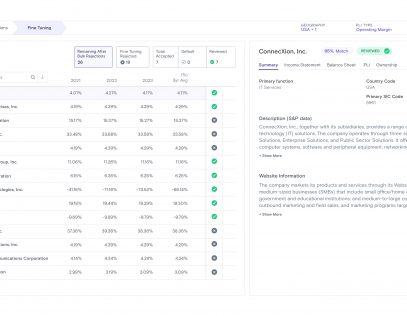Turning Tax into Business Intelligence: The Need for Tax Technology
Death, Taxes, and… Tech?
The breakneck propagation of data-analytic tools like artificial intelligence (AI) continues to transform nearly every facet of our lives. That very much includes the complex, labor-intensive realm of corporate taxation—traditionally marked by stacks of paperwork, labyrinthine regulations, and the ever-present fear of errors.
Like it or not, there’s nowhere to hide: As the global economy continues its march into digitalization, tax authorities around the globe are stepping up their demands for timely filings and responses for tax data—just as an expected uptick in transactional activity is poised to put additional stress on tax departments.
The good news is that there is no reason to hide. Beyond compliance and a low effective tax rate, what companies really crave is tax certainty. That calls for technologies that are not only protective, but proactive—capable of separating the digital wheat (decisions that can only be made by humans) from the digital chaff (process redundancies, manual error, and inefficiencies).
There’s plenty of confusion about what tax tech can (and should) do, and what it can’t (and shouldn’t) do. In this white paper, we break it all down, throwing a practical lens on the day-to-day realities of the multinational enterprise (MNE) tax director in areas like transfer pricing, R&D tax credits, and tax provision.
Curbing Tax Department Anxiety
When it comes to tools, the tried-and-true is a natural default for tax departments. After all, Mission One is to meet deadlines and protect the company from compliance mishaps. And let’s face it: some tax pros would rather you pry their Excel spreadsheets from their fingers than be forced to dive headfirst into the ocean of AI, where all kinds of perils, known and unknown, may swim.
There are plenty of valid reasons why tax professionals might harbor fears about integrating new technology into their departments. They run the gamut from costs, complexity and learning curves, to data security, disruption, and job displacement.
Granted, it can be really difficult to prove the ROI of a significant tech investment to non-technologists like CFOs, especially if you are not a technologist yourself (which few tax experts are). But here’s the key: technologies like AI, machine learning (ML), and robotic process automation (RPA) aren’t job-stealers, they’re force multipliers. They augment human capabilities—automating routine tasks like data entry, validation, and document management. This not only boosts efficiency, but it also frees tax professionals to focus on higher-value activities like strategic planning, decision-making, and complex analysis.
These tools harness exponential learning potential in a fraction of the time it would take to hire and train additional staff—especially helpful when you consider the dwindling talent pool in tax and accounting. (Every year, there are fewer young people majoring in accounting. Of those, fewer are becoming CPAs—and of those, fewer still are choosing a career in tax.)
Rather than introducing new risks, AI and ML are actually helping companies manage existing ones. They excel at learning from the past to optimize future strategies—which, if you think about it, is pretty much what tax professionals do. They enable proactive adjustments to minimize regulatory actions by analyzing the patterns that led to scrutiny and audits in the past. They can estimate future tax liabilities by gaming out the outcomes of potential tax disputes. They can even help predict future regulatory changes by analyzing real-time trends in tax law and calculating tax changes due to regulatory reform.
This is better than knowing the answers to a test in advance: it’s more like being able to read the mind of the teacher who will be grading your paper. How’s that for a superpower?
Visualizing Intelligence
It’s not just Instagram: Our minds are wired for visuals. When presented visually, scenario planning can pop. Tax consequences of various strategies become clearer—and so do decisions.
Data buried in mountains of spreadsheets is as good as invisible if it is not pulled up and put into relevant context: producing the kind of insights that can get a C-suite or board member to nod their head immediately. Visualization of data is business intelligence—and it’s another area where AI-based technologies really shine.
Imagine all the factors leading to tax consequences—what regions you operate in, product lines, tax legislation trends, intercompany transactions, tax payments, R&D locations, and more. These are all data points, and they all matter. AI, combined with ML, processes these data points efficiently, providing unparalleled business intelligence faster than an army of accountants, lawyers, and tax experts ever could.
The Taxonomy of Tax Technology
Unlike “generative” large-language models like ChatGPT—which are well known for “hallucinating” (aka, confidently making stuff up)—purpose-built ML-based tools are tuned to the highly specific needs of tax departments.
Here are specific ways tax experts leverage technology in some core functions:
- Transfer Pricing: Optimizing Intercompany Transactions: Transfer pricing—the art and science of pricing goods, services, and intellectual property among affiliated entities across different tax jurisdictions—is one of the most complex MNE tax issues. Data analytics and AI analyze vast datasets and identify patterns in global transactions, enabling enterprises to optimize their pricing strategies, and even offer predictive insights into potential compliance risks. Benchmarking databases and specialized software help tax experts streamline data gathering and eliminate manual errors, while document-management systems ensure that the extensive documentation required remains organized, accessible, and compliant with regulatory standards.
- R&D Tax Credits: Maximizing Innovation Incentives: R&D tax credits—designed to incentivize innovation and research in targeted areas—have never been more important to businesses, especially in globally competitive markets. Here again, tax technology streamlines the process of identifying, calculating, and claiming the credits—using automation to collect and organize project data, and AI to determine which activities and expenses are eligible. Documentation management software ensures compliance and audit readiness.
- Income Tax Provision: Enhancing Accuracy and Efficiency: The painstaking process by which the tax department calculates the company’s current and deferred income tax expense for financial reporting purposes is also greatly enhanced by technology—especially given the extremely tight deadlines. Automation boosts accuracy, reduces manual errors, and improves documentation, enhancing the company’s audit readiness. Machine learning identifies potential risks, errors, or inconsistencies that could lead to restatements or penalties while offering strategic insights.
- Corporate Planning: Strategic Decision-Making: Scenario planning is as complex as predicting the weather three weeks out: it requires massive data crunching. Sophisticated AI technologies play a pivotal role here, especially when integrated into broader enterprise workflows and data. Real-time data access and advanced analytics can simulate various tax scenarios—analyzing regulations and performance data in the light of compliance patterns—helping business leaders visualize tax implications.
Unlocking Tax Technology’s Strategic Potential
It’s no exaggeration to say that the convergence of tax and technology has ushered in a new era. The department’s future success will depend in large part upon how effectively they integrate technology into the enterprise’s larger operation. The degree of sophistication in this regard can vary among companies:
- Ad hoc/Reactive: At this level, individual tax departments largely work in isolation, using tax compliance software and some automation—but typically without integration into enterprise-level data.
- Proactive: MNEs who have the right technology mix and the strategic bandwidth integrate their tax software with enterprise data, coordinating with other departments from the get-go, and leveraging sophisticated data storage tools to enable “proactive compliance.”
- Optimized: Forward-looking companies fully automate tax workflows across the enterprise, drawing on rules-based technology for both reporting and proactive risk management, and allowing analytics to deeply inform their decision-making.
From Cost Center to Business Enabler
Without a doubt, technology holds the key to the future of tax. But there’s a right way and a wrong way of going about it. As we’ve stressed in this white paper, in a world awash in data, risks, and near-real-time regulatory demands, moving too slowly to adopt the best purpose-built tools can lead to much regret.
But there’s also the risk of overreliance on AI and other cutting-edge data technologies to solve complex, real-world problems. This is true across all business units—maybe most of all in the tax department, where a set-it-and-forget-it mentality could lead to painful mistakes.
Which brings us back, reassuringly, to human agency.
In essence, AI tools are insanely fast number crunchers, not decision-makers. They cannot replace human judgment: they can only inform, enhance, and amplify it. As such, they make humans more—not less—critical in all issues involving tax.
So perhaps a better way of framing the issue is this: AI won’t replace you—but companies who use it optimally will replace those who don’t.









